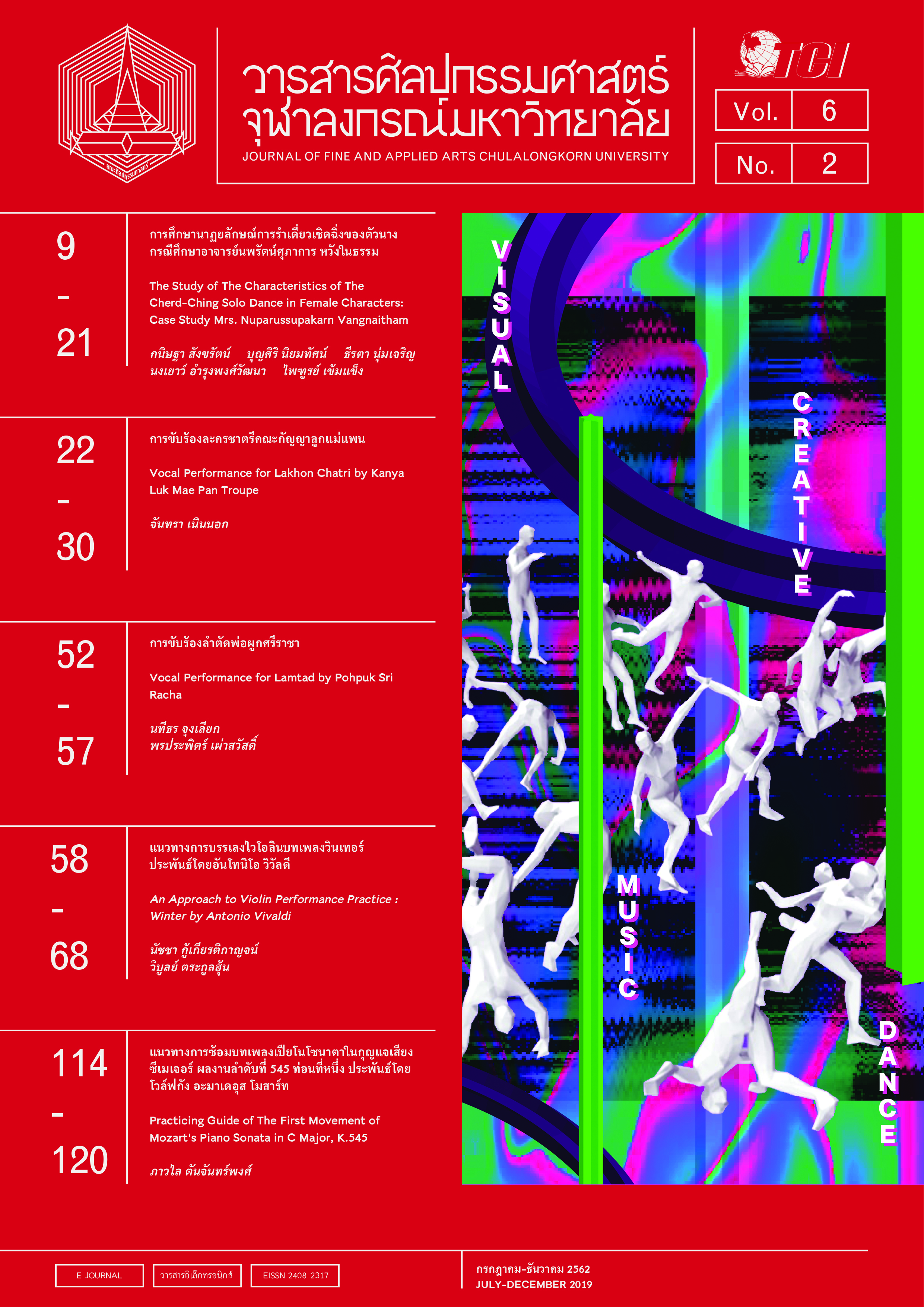การขับร้องลำตัดพ่อผูกศรีราชา
Keywords:
ลำตัด, พ่อผูกศรีราชา, การขับร้องลำตัด, ลำตัดศรีราชา, LAMTAD, POH PUK, SRI RACHAAbstract
บทคัดย่อ
งานวิจัยเรื่องการขับร้องลำตัดพ่อผูกศรีราชา มีวัตถุประสงค์เพื่อศึกษาประวัติความเป็นมาและกลวิธีการขับร้องลำตัดของคณะลำตัดพ่อผูก ศรีราชา ผลการศึกษาพบว่าคณะลำตัดพ่อผูกศรีราชา ก่อตั้งโดยนายผูก เอกพจน์ ใน พ.ศ.2486 แม่ประพิมพ์ เอกพจน์ เป็นบุตรของพ่อผูกสืบทอดลำตัดแบบเก่าและดั้งเดิมตามที่ได้รับการถ่ายทอดจากบรรพบุรุษในการแสดงลำตัดนั้น ใช้รำมะนา 4 ลูก ฉิ่ง และ คนร้อง ซึ่งบทเพลงที่โดดเด่นที่พ่อผูกได้ประพันธ์ไว้คือ ลำตัดลำตัด ก ไก่ - ฮ นกฮูก
จากการวิเคราะห์การขับร้องลำตัด ก ไก่ ถึง ฮ นกฮูกซึ่งนางประพิมพ์ เอกพจน์ ได้รับการถ่ายทอดมาจากนายผูก เอกพจน์ ผู้เป็นบิดา พบว่า มีจำนวนทั้งหมด 3 ช่วง คือช่วงเกริ่นนำ ช่วงเนื้อเพลง และช่วงท้าย โดยในช่วงเกริ่นนำจะไม่มีจังหวะ จะเริ่มเข้าจังหวะในช่วงเนื้อเพลงและช่วงท้าย กลวิธีที่ใช้ในการขับร้องทำนองลำตัดใช้กลุ่มเสียงเดียว การใช้ทางเอื้อน 2 เสียงโดยใช้เสียง 2 พยางค์ ติดกัน และใช้เสียง 3 พยางค์ การตกแต่งทำนองด้วยเสียงเอยต้นประโยค การใช้ลมหายใจตั้งแต่ 7 – 8 ห้อง และ แบ่งเป็น 4 ห้อง การใช้ลมหายใจ 3 ห้อง การเน้นเสียงในห้องที่ 3 และ 4 ที่ใช้สระเสียงยาว ซึ่งแสดงให้เห็นถึงความสามารถด้านการประพันธ์ทางร้องและกลวิธีการขับร้องซึ่งได้รับการสืบทอดจากรุ่นสู่รุ่นได้เป็นอย่างดี
Abstract
The study aims to investigate the history and techniques of the vocal performance For Lamtad By Pohpuk Sri Racha. It reveals that the Pohpuk Sri Racha group was founded by Mr.Puk Akepoj In 1943. Mrs.Prapim Akepoj is Pohpuk’s danghter who received and continued the original style of Lamtad performance from her father.The performance of Lamtad entails four Ramana (a frame drum), Ching (a pair of cymbol) and the vocalists. The master piece of Pohpuk was. Lamtad Kor Kai – Hor Nokhook.
According to the analysis of the vocal performance of Kor Kai – Hor Nokhook, it is able to show the quality of the author’s performance and vocal techniques. Mrs.Prapim Akepoj had been passed on all the vocal techniques from Mister Puk Akepoj. The vocal parts are consisted of 3 parts: introduction, the lyric and the ending on the introduction’s part. In the introduction, there was no rhythmic accompaniment. The techniques used for vocal performances are employed only for a group of single voice by drawing out a note by using 2 syllables and 3 syllables. The decorations of the melody were done by using the sound “aoey” at the beginning of the sentence. Other techniques included breathing techniques with 7- 8 measures and it was divided into 4 measures as well as 3 measures. The accentuation is normally found in the third and the fourth measure of the sentence.
Downloads
Published
Issue
Section
License
ลิขสิทธิ์ของบทความเป็นของเจ้าของบทความ บทความที่ได้รับการตีพิมพ์ถือเป็นทัศนะของผู้เขียน
กองบรรณาธิการไม่จำเป็นต้องเห็นด้วยและไม่รับผิดชอบต่อบทความนั้น






